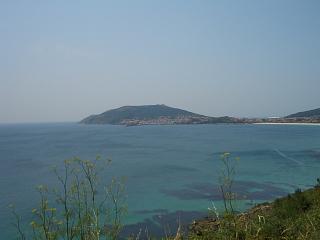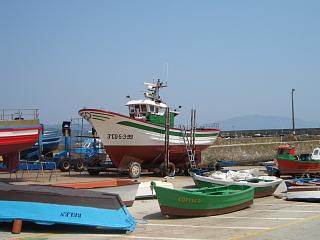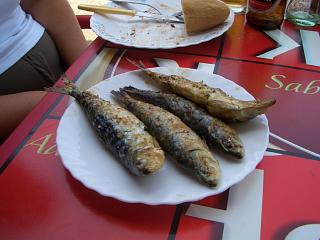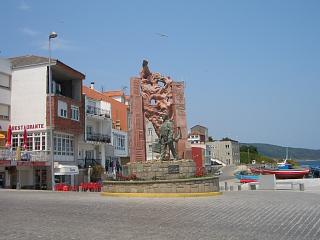Seaport Finisterre (Fisterra) Updated August 2006
Finisterre is situated mid-way between the "rias altas" and "rias baias" (upper and lower bays of Galicia) and is approximately one hour from la Coruna city on the
 AC552 and a similar driving duration from Santiago de Compostela on the AC546 and then the AC441. Both routes are scenic and take you through the Serra de Santiago.
AC552 and a similar driving duration from Santiago de Compostela on the AC546 and then the AC441. Both routes are scenic and take you through the Serra de Santiago.
If you drive to the top of the mountains shadowing the holiday town Muros (to the south), the Cape of Finisterre can be seen in the distance on a clear day.
About Finisterre
Finisterre is a very famous fishing port, it is well known throughout Spain and you will see many signs directing you towards it and discover several tourist leaflets suggesting you visit it. The signs will call it Fisterra and it is at the western most point of Galicia, known as the costa da morte.
There are two areas of potential tourist interest in Finisterre. The first is a small castle ruin on the hill above the town and the second is the port area at the foot of the town. In truth we found both disappointing, but others may disagree.
On arriving in Fisterra parking is a definite problem with many of the old streets, lying on the incline on to which the town is built, being only single track in width. Finding a spot at
 the top of the town and close to the castle is easier, but easier still is parking by the port itself where extensive regeneration work is currently taking place. There is a large car park at this spot.
the top of the town and close to the castle is easier, but easier still is parking by the port itself where extensive regeneration work is currently taking place. There is a large car park at this spot.
Beauty is always in the eye of the beholder, but after a long drive down the coast from Noia to visit Finisterre, we found it to be a drab and poorly maintained town during our first visit in 2002. Since then however, the development of the key side area around the port has certainly improved the town and, although it remains far from picturesque, the unkempt appearance has certainly been enhanced.
Walking around Finisterre again offers nothing of any great tourist interest. There is a modern sculpture dedicated to the seafarers of the town, but Finisterre is very much a working fishing village and concessions to tourism are few. There are no quaint churches, no rambling parades of terraced cottages and no alameda. Flower laden squares and colonnaded medieval buildings are all absent and the archetypal image of the pretty Galician seaside town is, for once, a myth.
Where Fisterra does score points is in the port side café bars that really do serve the freshest seafood to be had. These bars are nothing special to look at and most tourists will
 dismiss them without a second look, but this is their loss. The sardines, squid and various other catches are prepared and cooked, sometimes within minutes of being landed, and they are second to none. We sampled the famous barbeque grilled sardines along with some chimirones (grilled whole squid) at one of these bars and they were literally a gift from the gods. The sardine are ordered and paid for per fish and are served with a fresh and crispy bread. You eat them whilst looking out at the port and quite possibly having the boat that caught them within your gaze. Despite Finisterre’s other failings, this gastronomic experience made the visit worthwhile, at least in our eyes. If you do decide to explore Finisterre, our recommendation would be to make it a culinary rather than a cultural or historic exploration – that way you will not be disappointed.
dismiss them without a second look, but this is their loss. The sardines, squid and various other catches are prepared and cooked, sometimes within minutes of being landed, and they are second to none. We sampled the famous barbeque grilled sardines along with some chimirones (grilled whole squid) at one of these bars and they were literally a gift from the gods. The sardine are ordered and paid for per fish and are served with a fresh and crispy bread. You eat them whilst looking out at the port and quite possibly having the boat that caught them within your gaze. Despite Finisterre’s other failings, this gastronomic experience made the visit worthwhile, at least in our eyes. If you do decide to explore Finisterre, our recommendation would be to make it a culinary rather than a cultural or historic exploration – that way you will not be disappointed.
The castle at the top of the town may offer some additional interest to visitors of Fisterra. It certainly affords good views out to sea and back into the ria de Corcubion, but the ruin can be explored in a matter of minutes and the time spent in locating a parking spot did not, in our opinion, warrant the final reward.
The "Coast of Death"
In the times of the Romans and Celts, Finisterre (called "finis terrae") was
 considered to be at the farthest edge of the north westerly land mass and was described as "the end of the earth" (in Latin, "finis terrae" means "end of the world"). Finisterre also possesses a reputation for being on "the coast of death", since many vessels have left the port, never to return. Finisterre's main claim to fame is its continued activity as a Galician fishing port and if you wonder down to its harbour you will see and smell the fishing nets, laid out to dry.
considered to be at the farthest edge of the north westerly land mass and was described as "the end of the earth" (in Latin, "finis terrae" means "end of the world"). Finisterre also possesses a reputation for being on "the coast of death", since many vessels have left the port, never to return. Finisterre's main claim to fame is its continued activity as a Galician fishing port and if you wonder down to its harbour you will see and smell the fishing nets, laid out to dry.
Summary
On a positive note, Finisterre does not pretend to be anything other than what it is, a working fishing town, and if this is what you want to see, then you won't be disappointed. As already mentioned, we felt that the town of Finisterre did not reward the journey necessary in order to get there, but this is a purely personal view. Certainly, if you want to see a town that genuinely represents Galicia’s sea faring past, Finisterre will not disappoint and if you combine that with some port side eating you may well decide that the trip is worthwhile.
Another view
The best recommendations, for or against anywhere, always come from the subjectives views of those who visit, so here is one, courtesy of Gabriele Schafer.
As I read the "Galicia Guide" on the internet I must make a short addition to your page on Finisterre.
I have visited Finisterre in the summertime as well as in winter. I find this charming little fishing village to be extraordinary.
The scenery is breathtaking, Cabo Finisterre is magic, the Romanesque churches on the way are beautiful , the village is inviting, friendly, helpful people are kind and make sure you find accommodations, even out of season. Good seafood at a good price. I love this place and its fine people. I will return.
Gabriele Schafer, Fayetteville, Arkansas USA

